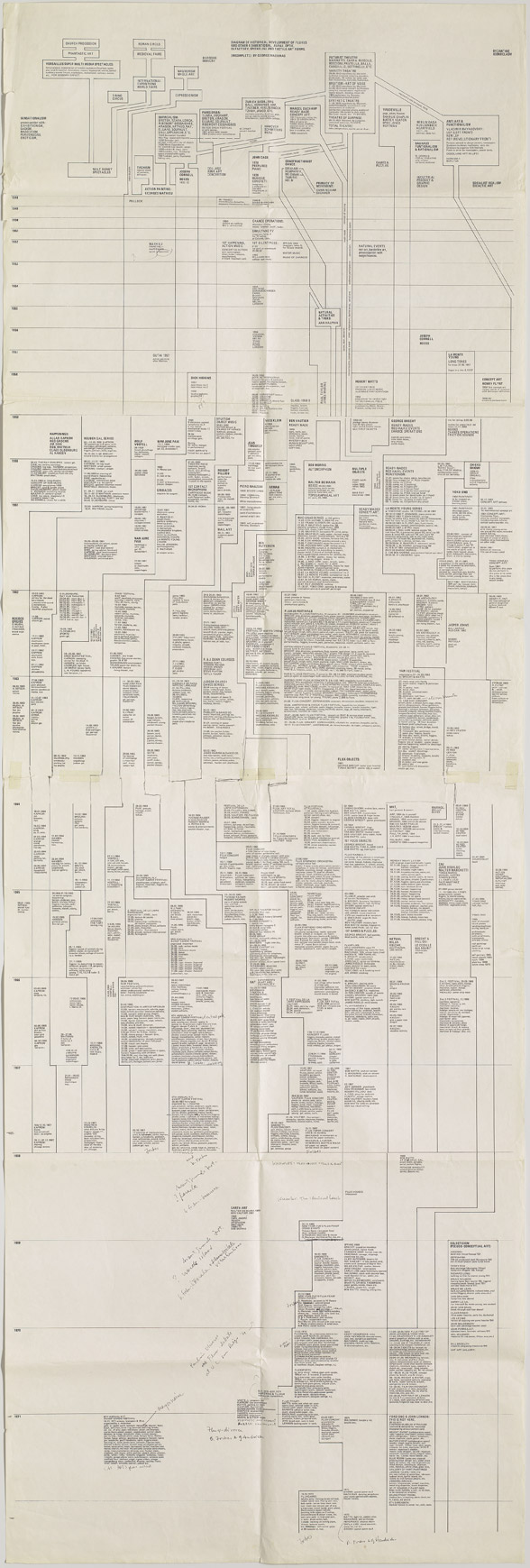(AROUND) LA MONTE YOUNG |
back / retour : — La Monte Young Poem — La Monte Young Papers Writings —
HENRY FLYNT(Edit)
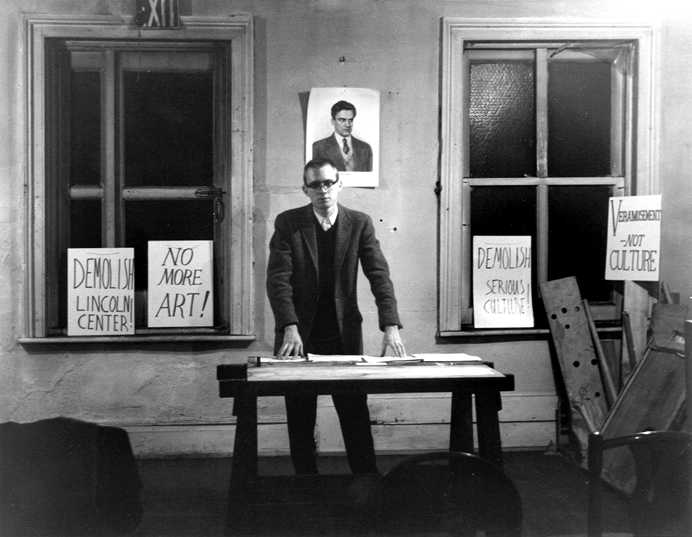 Henry Flynt, conférence "From Culture to Veramusement from culture to Brend", dans le loft de Walter De Maria, Bond Street, New York, 28 février 1963, (portrait : Maïakovski), photo: Diane Wakoski Source : http://www.henryflynt.org/overviews/hfphotos.html | "DEMOLISH SERIOUS CULTURE! /DESTROY ART!"; "DEMOLISH ART MUSEUMS! / NO MORE ART!"; "DEMOLISH CONCERT HALLS! /DEMOLISH LINCOLN CENTER!" — slogans utilisés par Henry Flynt, Tony Conrad et Jack Smith lors du piquet de grève qu'ils ont organisé le 27 février 1963 devant le Museum of Modern Art, le Metropolitan Museum, et le Lincoln Center à New York. "Anti-Art Pickets Pick on Stockhausen" Action Against Cultural Imperialism (Flynt, Maciunas) le 8 septembre 1964 déclare lors de la représentation d'Originale de Stockhausen lors du Annual New York Festival Avant-Garde (dirigé par Charlotte Moorman) : « There is a Brussels European Music Competition to which musicians come from all over the world; why is there no Competition, to which European Musicians come, of Arab Music ? (Or Indian, or Classical Chinese, or Yoruba, or Bembey, or Tibetian percussion, or Inca, or hillbilly music?) »[1] (le "Stockhausen Serves Imperialism" de Cornelius Cardew sera publié en 1974, et le "Blues People" de LeRoi Jones (Amiri Baraka) fût publié en 1963) « [...] explorer les possibilités esthétiques que la structure peut avoir une fois libérée de sa tentative d’être de la musique ou autre. » Source : Michel Oren, "Anti-Art as the End of Cultural History", Performing Arts Journal, Vol. 15, No. 2. (May, 1993), pp. 1-30.[2] |
| Henry Flynt - Essay : Concept Art (1961) The first step in straightening out for example structure music is to stop calling it "music", and start saying that the sound is used only to carry the structure and that the real point is the structure — and then you will see how limited, impoverished, the structure is. Incidentally, anyone who says that works of music do occasionally have musical value just doesn't know how good real music (the Goli Dance of Baoule ; "Cans on Windows" ["Two Sounds] by L. Young, the contemporary hit song "Sweets for my Sweets", by the Drifters [a rythmn and blues band] can get. When you make the change, then since structures are concepts, you have concept art. Incidentally, there is another, less important kind of art which when straightened out becomes concept art: art involving play with the concepts of the art such as, in music, "the score," "performer vs. listener," "playing a work." The second criticism of structure art applies, with the necessary changes, to this art. [...] I can now return to the question of why concept art is "art." Why isn't it an absolutely new, or at least a non-artistic, non-aesthetic activity? The answer is that the antecedents of concept art are commonly regarded as artistic, aesthetic activities; on a deeper level, interesting concepts, concepts enjoyable in themselves, especially as they occur in mathematics, are commonly said to "have beauty." By calling my activity "art," therefore, I am simply recognizing this common usage, and the origin of the activity in structure art and mathematics. | "La première étape pour redresser la structure de la musique est de cesser de l'appeler "musique", et commencer à dire que le son est uniquement utilisé pour transporter la structure et que le vrai problème, c'est la structure [...]" — (Henry Flynt, "Concept Art", 1961) Henry Flynt est un des maîtres du 20ème siècle. En tant que philosophe, il a instauré les bases du « nihilisme cognitif ». Il a ainsi publié des articles sur la métaphysique, l'économie, la sociologie et la philosphie culturelle. C'est en tant que compositeur et violoniste qu'il commença sa carrière dans les années 60 entouré d'artistes tels que Tony Conrad et La Monte Young. Lors de la cinquième conférence de sa série « From “Culture” to Veramusement » (contraction du latin veritas et de l’anglais amusement), prononcée à l’occasion de la manifestation de février 1963 contre la culture sérieuse, Flynt s’en prit au snobisme de cet élitisme culturel, debout devant le portrait de Vladimir Maïakovski. Quelques jours plus tard, le 8 février 1963, il fit une conférence-démonstration dans l’atelier de Walter de Maria dans laquelle il s’attaquait au Lincoln Center en préconisant toujours cette même annihilation : « No more art ! Demolish Serious Culture ». L’utopie humaniste est Henry Flynt obscurcie par une lucidité exacerbée qui le pousse à considérer la civilisation comme une épave (« Tout ce qui est organique est mort et en décomposition et tout ce qui n’est pas organique est tordu ou foutu », The Wire, 2001) et à défendre l’idée philosophique du « nihilisme cognitif ». Il n’y a ni langage ni connaissance, et pour Flynt une partie de la réponse viendra de la musique. Le terme de « Concept Art » précède en 1961 ainsi celui d’« Art conceptuel », attribué à Sol LeWitt et à son texte « Paragraphs on Conceptual Art » publié dans la revue Artforum en 1967. Flynt était initialement amené à définir le « Concept Art » à travers une critique de ce qu’il appelait « l’art structurel », en particulier la sérialité intégrale alors dominante dans la composition musicale contemporaine (Dans ce texte, il est question pour Flynt d’inventer un art dont le matériau serait le concept et dont la beauté serait analogue à celle des formules mathématiques). Si la logique structurelle ou compositionnelle de la musique sérielle s’est révélée pour l’auditeur impossible à discerner, comme le soutient Flynt, il aurait été plus enrichissant de se concentrer sur la structure elle-même : « [...] d’explorer les possibilités esthétiques que la structure peut avoir une fois libérée de sa tentative d’être de la musique ou autre », tels les exemples les plus connus de la série des "Compositions 1960" de La Monte Young : « faire un feu devant le public » (Composition 1960 N° 2), ou « libérer un ou plusieurs papillons dans l’espace de l’auditorium » (Composition 1960 N° 5), pièce que l’auteur justifie ainsi : « N’est-il pas merveilleux d’écouter quelque chose que l’on est ordinairement censé regarder ? ». Composition 1960 N° 10, dédiée à Bob Morris, permet elle aussi une double lecture, sonore et visuelle : « dessinez une ligne droite et suivez-là ». C’est à ce sujet que Henry Flynt parlera un an plus tard de "Concept art". Flynt avait promu l’idée d’une culture non-cognitive comme un moyen de libérer l’activité créatrice (ou expression humaine) des étalons de valeur « objectif » et « intersubjectif » auxquels une grande part de l’art conceptuel s’attachait. En 1982 il abandonne l’art et renie la musique classique occidentale pour s’intéresser aux musiques ethniques comme le blues ou la country qu’il nomme justement "culture acognitive". La pratique d’Henry Flynt permettra de poser l’hypothèse d’une culture acognitive, et conséquemment d’ouvrir les portes à une nouvelle pensée esthétique. L’art permettrait ainsi un accès non-cognitiviste à la culture et formerait une esthétique qui suspend les processus de la réflexion et de la reconnaissance. Les risques de cette esthétique ne sont pas moindres ; on peut en relever au moins deux : le solipsisme et le relativisme. Le pari de la culture acognitive reste néanmoins à défendre, il s’agit de retrouver le sens originel de nos activités quotidiennes en les dépouillant des constrictions idéologiques auxquelles elles sont habituellement soumises. Pour Flynt, le but de l’art est de démanteler les structures conventionnelles de la pensée, dont la philosophie analytique et le cognitivisme lui apparaissent comme les forteresses les plus résistantes. L’idée fondamentale d’une critique de la culture philosophique et de l’esthétique traditionnelle est tout d’abord nommée par Flynt « culture générale acognitive », ensuite « veramusement » et finalement « brend ». Source : http://www.cairn.info/article.php?ID_ARTICLE=PHOIR_027_0197 |
Le contexte musical à New York (et entre l'Europe et l'Amérique du Nord) était très viviviant et dynamique : entre la musique sérielle, la musique électronique et la musique indéterminée ; et entre le renouvellement des formes, du concert à la performance et au happening (Fluxus). De nombreux débats ont animé la communauté des artistes dont l'un des protagonistes les plus marquants est Henry Flynt (et du côté des arts plastiques, George Maciunas). Henry Flynt et La Monte Young ont collaboré plusieurs fois au début des années soixante, pourtant des divergences vont les séparer à partir de 1963, notamment à propos de la place de l'art expérimental dans la société. Henry Flynt marquera des positions pour l'"anti-art" et la "culture acognitive" ainsi qu'une lutte vis-à-vis de l'establishment en faveur d'anti-modèles. De son côté La Monte Young s'appuiera sur un radicalisme sans doute moins politique mais plus ancré dans l'alternative musicale et un renouvellement de l'expérience musicale.
Le soir du 29 avril 1964, un groupe s'appelant Action Against Cultural Imperialism (AACI) réalisa une manifestation devant le Town Hall à New York où avait lieu au même moment un concert organisé par le gouvernement ouest-allemand, comprenant des œuvres de Stockhausen, Henze, Hindemith et d'autres compositeurs. Les interprètes du concert incluaient Stockhausen, David Tudor et le percussionniste Max Neuhaus. Parmi les manifestants se trouvaient Henry Flynt, Ben Vautier, Takako Saito, Ikuko Iijima, George Maciunas. Les slogans sur les affiches étaient explicites : "Fight Racist Laws of Music !", "Fight the Rich Man's Snob Art", etc. Le 8 septembre une seconde manifestation fût organisée par l'AACI avec les mêmes participants (sauf Ben Vautier remplacé par l'activiste Marc Schleifer, Iijima était absente, et ont rejoints les manifestants Alan Marlowe et Tony Conrad, membre du collectif d'improvisation de La Monte Young, The Theatre of Eternal Music). L'occasion et l'objectif de cette seconde manifestation était le concert d'une œuvre de Stockhausen, "Originale", dans le cadre du Second Annual Avant Garde Festival dirigé par Charlotte Moorman. Le concert était dirigé par Allan Kaprow et parmi les interprètes se trouvaient Charlotte Moorman, Allen Ginsberg, Dick Higgins, Nam June Paik, James Tenney, Alvin Lucier, Max Neuhaus, Olga Adorno et Jackson MacLow. La confusion était plutôt à son comble (du fait que tous ces artistes se connaissaient bien, mais se retrouvaient là en quelque sorte chacun de l'autre côté de la barrière ; Allen Ginsberg par exemple rejoint la manifestation), si bien qu'en fait les journalistes et le public ont crû que la manifestation faisait partie d'Originale. Pourtant les slogans étaient très clairs : "Stockhausen - Patrician 'Theorist' of White Supremacy : Go to Hell !". Arnold Schönberg commenta l'événement dans le New York Times : "Certains dirent qu'ils faisaient partie du concert, d'autres dirent le contraire, dont les manifestants, mais personne ne les croyait. [...] Ils ressemblaient aux interprètes d'Originale, ils jouaient de la même manière, et ils portaient les mêmes types de vêtements." En fait l'impact de la manifestation organisée par Flynt et Maciunas rata son objectif à cause de cette confusion.
La position de Flynt (et de Maciunas) a marqué une point critique sur la capacité de l'avant-garde (musicale) à analyser les hiérarchies présentes (et sous-jacentes) sociales et culturelles. En prenant des positions de gauche (voire gauchistes, maoïstes), certains clivages sont apparus. Cette prise de position de Flynt est issue de ses relations avec les musiciens sur la période 1960-1964, notamment avec La Monte Young :
- La Monte Young était très impliqué dans la musique jazz (Ornette Coleman, Cecil Taylor, Don Cherry, etc.) et Flynt voulait défendre aussi le versant de la musique "populaire" et vernaculaire : la musique afro-américaine (le blues) comme racine, la musique commerciale (Little Richard, R&B, le rock'n'roll), tout autant que la musique traditionnelle du monde entier. Il voulait démontrer que son approche était une critique de la "haute" culture européenne et américaine tout en montrant son intérêt pour les prédilections de l'avant-garde à propos des innovations formelles, de la nouveauté, de l'engagement dans des nouvelles technologies sonores, et de la complexité sonore et musicale. Son intérêt était de connecter l'ensemble de ces éléments (musique populaire vernaculaire et musique expérimentale) pour une lutte contre l'impérialisme (musical).
Sa confrontation avec La Monte Young (malgré leurs points de convergence : improvisation vs langage, le blues, le non-sensationnel, etc.) eût lieu sur le mixage compositionnel entre le jazz (free) et les règles vernaculaires du blues et l'impact des musiques populaires (R&B, r'n'r) de l'époque. Flynt voulait faire exploser les frontières et et supprimer les standards musicaux, mais surtout il voulait briser l'élitisme. La Monte Young le contredira considérant de son côté le jazz comme justement une culture alternative nécessaire pour une rupture avec le "populisme". Pour résumer, Flynt s'immerge dans l'univers populaire tout en devenant idéologue (de la folk music), et La Monte Young intensifie son travail dans l'alternatif et la rareté (même le Theatre of Eternal Music avec ses allures de "groupe rock" ne jouera que des concerts privés ou dans des galeries d'art). Flynt s'offusque de la position "sérieuse" de La Monte Young, position qui est pour lui insoutenable idéologiquement parlant, et dira que les compositeurs de cette avant-garde n'étaient pas intéressés par penser "d'autres choses" autres que ce qui concerne la musique sérielle et la musique indéterminée. D'ailleurs lors de la manifestation anti-Stockhausen organisé par Flynt et Maciunas, La Monte Young dira qu'il n'était pas convaincu que c'était l'action appropriée qu'il fallait mener.
- Le second point de divergence était sur le concept de "nouveauté" que La Monte Young a mis en avant dans son texte "Conference 1960", nouveauté étant synonyme d'originalité, d'expérimentation, d'innovation, de liberté, etc. Flynt le contredira en énonçant dans sa conférence du 5 juin 1961 que la nouveauté ne peut pas être le seul critère de jugement de valeur d'une œuvre d'art, puisqu'une œuvre d'art est déjà évaluée en tant qu'art. Flynt conclut que la nouveauté n'est qu'un caractère second et que le premier de ces caractères est la détermination par le contexte. Flynt défendait la notion d'anti-art et d'art conceptuel, et celle de culture a-cognitive, et il voulait proposer ceci comme radicalités à la communauté musicale expérimentale : surpasser le moderne par le radical, plus de ballet, plus d'opéra, etc. Il percevait dans les œuvres musicales (et performatives) de l'époque la persistance des modèles culturels et des obligations sociales (et autoritaires) qui vont à l'encontre de l'expression individuelle (de l'authenticité de l'expérience) : le "public", le rituel du concert, les formes conventionnelles, le snobisme intellectuel, le ringardisme, etc. No More Art !
- Source :
- Benjamin Piekut, "Experimentalism Otherwise: The New York Avant-Garde and Its Limits", Berkeley & Los Angeles, University of California Press, 2011
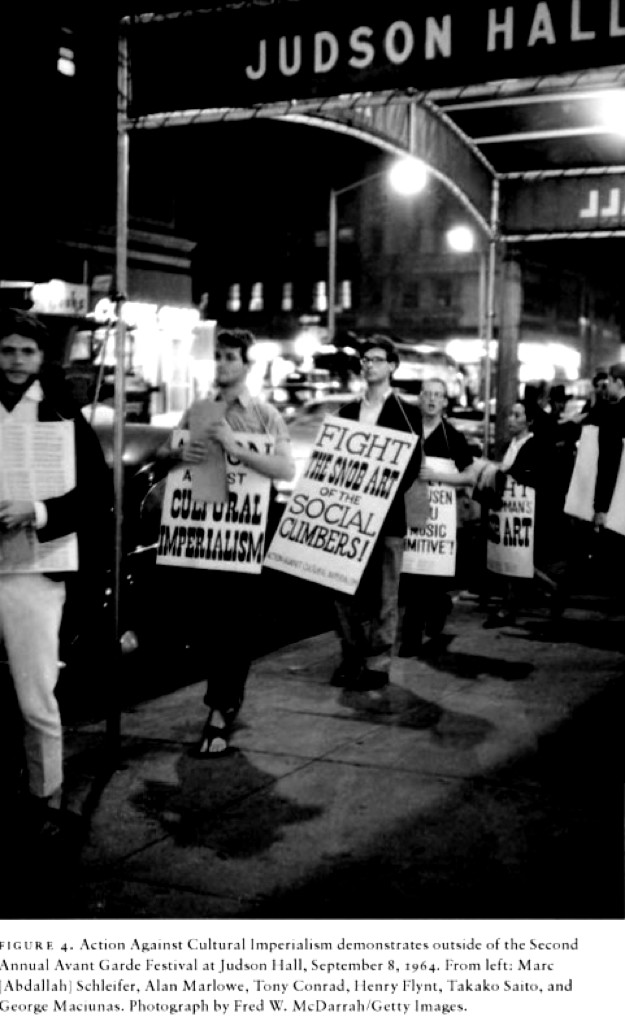
ACTION AGAINST CULTURAL IMPERIALISM CALLS ON YOU TO
FIGHT MUSICAL DECORATION OF FASCISM!
JOIN THE DEMONSTRATION AT THE WEST GERMAN COMPOSERS CONCERT,
TOWN HALL (43RD. STREET WEST OF SIXTH AVENUE), WEDNESDAY, APRIL 29, 8:00PM
In a lecture at Harvard in the fall of 1958, Stockhausen contemptuously dismissed "jazz" as "primitive... barbaric... beat and a few single chords...", and in effect said it was garbage.
By the time he made that dscist-like attack on Afro-American music, Stockhausen was a well-known symbol of contempt and disdain for every kind of workers', farmers', or non-European music, whether the music of Black Americans, East European peasants, Indians, or even most of the music that West Germans workers themselves like. All of the West German composers on tonight's program share this contempt; Stockhausen is their most significant representative.
[...]
FIGHT FASCIST MUSICAL THOUGHT!
STOCKHAUSEN GET OUT!
TOO MANY LIKE YOU HERE ALREADY!
Action Against Cultural Imperialism
359 Canal Street, New York, N. Y. 10013.
Ref : http://www.artnotart.com/fluxus/hflynt-fightmusicaldecor.html
Ref : http://www.artnotart.com/fluxus/hflynt-actionagainst.html
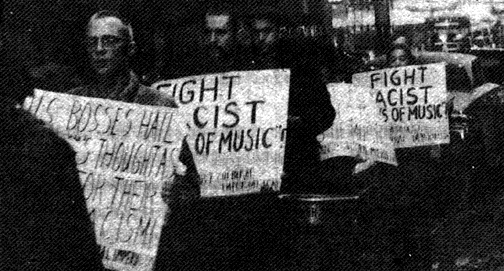
Video recording of the premiere of Originale, 1964 sept the 8th, Judson Hall, New York. Conductor : Allan Kaprow
Film by Peter Moore, Barbara Moore (Prod.) & Susan Brockman (Ed.)
- Director - Allan Kaprow
Assembled and rehearsed the cast and directed the show. He is the bearded man seen near the end of the film reading from a book and then holding large clumps of straw. - Pianist - James Tenney
A pioneer composer of electronic music as well as a performer of Stockhausen's and others' music. Seen here performing Kontakte. - Percussionist - Max Neuhaus
Perfomer of Cage, Stockhausen, Feldman and many other composers, and later a creator of his own sound art works. Seen here performing Kontakte with Tenney. The duo began the evening in formal concert dress, but had several costume changes including states of undress as seen later in the film. (The feral costume worn by Tenney was created by artist Carolee Schneemann.) - Film Man - Robert Breer
Noted avant-garde filmmaker and animator. His film "Fist Fight," which according to Barbara Moore consists of baby pictures of the cast interspersed with animation, is seen playing during the performance. - Action music - Nam June Paik
- Child - Anton Kaprow
The child plays with boxes to the side of stage, and also, in Stockhausen scholar Robin Maconie's phrase, "acts as a silent observer of what the adults are up to." - Models - Olga Adorno (performer, and at that time Billy Klüver's wife, she will be later Jean Dupuy's wife) and Lette Eisenhauer (painter, filmaker)
Both women were performers in early 60s events in New York. Eisenhauer especially was a contributor to Kaprow's early happenings - String Player - Charlotte Moorman
Seen playing the cello while lying on the floor and later from the balcony. - Jazz Musician - Don Heckman
Seen playing saxophone. Later moved into jazz journalism. Together with Ed Summerlin, curated the jazz events at Moorman's festivals. - Actors
include Dick Higgins and Jackson Mac Low, two language artists associated with Fluxus. Mac Low is seen near the beginning of the film, wearing the CORE/Freedom Now shirt. - Conductor - Alvin Lucier
The noted electronic music composer is briefly seen conducting the actors in their simultaneous readings. - Painter - Robert Delford Brown
Commissioned the film from Moore. Replaced by Fluxus artist Ay-O after a disagreement with Kaprow. - Poet - Allen Ginsberg
The Beat poet is seen early in the film observing the models, then drinks water from Nam June Paik's shoe, and later chants mantras in his role as "the poet."
DOCS(Edit)
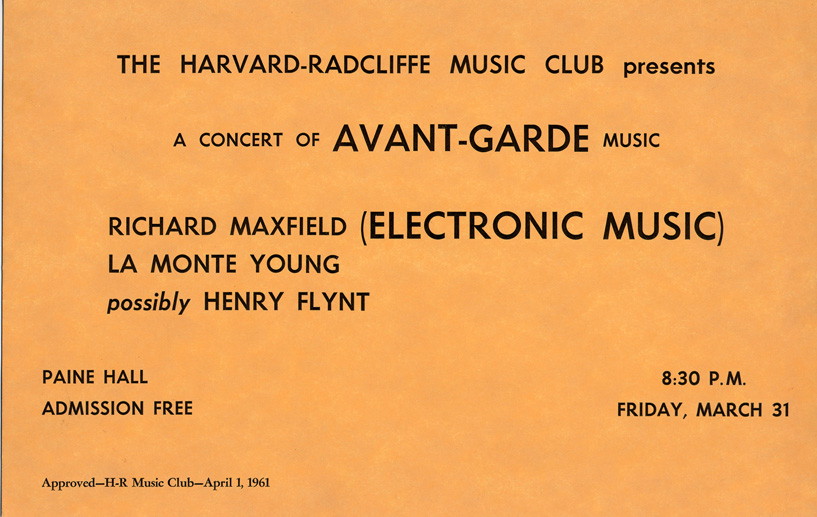
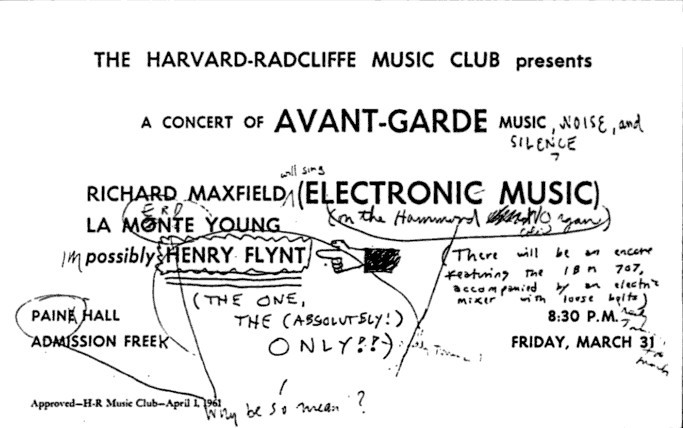
(In "Sound and Light, La Monte Young and Marian Zazeela", p. 60)
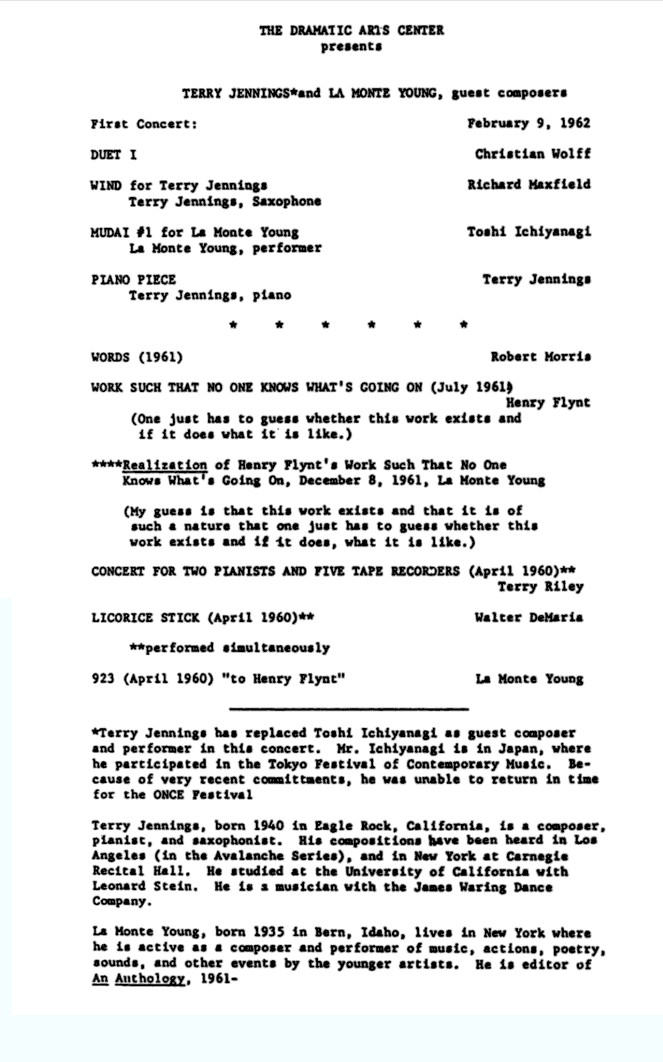
Concert organisé par Henry Flynt, 31 mars 1961, Harvard University, Cambridge, MA, USA.
ART or BREND ? (1968)
don't like or enjoy it? This question really lays art open. One of the distinguishing features of art has always been that it is very difficult to defend art without referring to people's liking or enjoying it. (Functions of art such as making money or glorifying the social order are real enough, but they are rarely cited in defense of art. Let us put them aside.) When one artist shows his latest production to another, all he can usually ask is "Do you like it?" Once the "scientific" justification of art is discredited, the artist usually has to admit: If you don't like or enjoy my product, there's no reason why you should "consume" it.
There are exceptions. Art sometimes becomes the sole channel for political dissent, the sole arena in which oppressive social relations can be transcended. Even so, subjectivity of value remains a feature which distinguishes art and entertainment from other activities. Thus art is historically a leisure activity.
[3.] But there is a fundamental contradiction here. Consider the object which one person produces for the liking, the enjoyment of another. The value of the object is supposed to be that you just like it. It supposedly has a value which is entirely subjective and entirely within you, is a part of you. Yet—the object can exist without you, is completely outside you, is not your or your valuing, and has no inherent connection with you or your valuing. The product is not personal to you.
Such is the contradiction in much art and entertainment. It is unfortunate that is has to be stated so abstractly, but the discussion is about something so personal that there can be no interpersonal examples of it. Perhaps it will help to say that in appreciating or consuming art, you are always aware that it is not you, your valuing—yet your liking it, your valuing it is usually the only thing that can justify it.
In art and entertainment, objects are produced having no inherent connection with people's liking, yet the artist expects the objects to find their value in people's liking them. To be totally successful, the object would have to give you an experience in which the object is as personal to you as your valuing of it. Yet you remain aware that the object is another's product, separable from your liking of it. The artist tries to "be oneself" for other people, to "express oneself" for them.
[4.] There are experiences for each person which accomplish what art and entertainment fail to. The purpose of this essay is to make you aware of these experiences, by comparing and contrasting them with art. I have coined the term `brend' for these experiences.
Consider all of your doings, what you already do. Exclude the gratifying of physiological needs, physically harmful activities, and competitive activities. Concentrate on spontaneous self-amusement or play. That, is concentrate on everything you do because you like it, because you just like it as you do it.
Actually, these doings should be referred to as your just-likings. In saying that somebody likes an art exhibit, it is appropriate to distinguish the art exhibit from his or her liking of it. But in the case of your just-likings, it is not appropriate to distinguish the objects valued from your valuings, and the single term that covers both should be used.
When you write with a pencil, you are rarely attentive to the fact that the pencil was produced by somebody other than yourself. You can use something produced by somebody else without thinking about it. In your just-likings, you never notice that things are not produced by you. The essence of a just-liking is that in it, you are not aware that the object you value is less personal to you than your very valuing.
These just-likings are your "brend." Some of your dreams are brend; and some children's play is brend (but formal children's games aren't). In a sense, though, the attempt to give interpersonal examples of brend is futile, because the end result is neutral things or actions, cut off from the valuing which gives them their only significance; and because the end result suggests that brend is a deliberate activity like carrying out orders. The only examples for you are your just-likings, and you have to guess them by directly applying the abstract definition.
Even though brend is defined exclusively in terms of what you like, it is not necessarily solitary. The definition simply recognizes that valuing is an act of individuals; that to counterpose the likes of the community to the likes of the individuals who make it up is an ideological deception.
[5.] It is now possible to say that much art and entertainment are pseudo-brend; that your brend is the total originality beyond art; that your brend is the absolute self-expression and the absolute enjoyment beyond art. Can brend, then, replace art, can it expand to fill the space now occupied by art and entertainment? To ask this question is to ask when utopia will arrive, when the barrier between work and leisure will be broken down, when work will be abolished. Rather than holding out utopian promises, it is better to give whoever can grasp it the realization that the experience beyond art already occurs in his or her life—but is totally suppressed by the general repressiveness of society.
Note: the avant-garde artist may raise a final question. Can't art or entertainment compensate for its impersonality by having sheer newness as a value? Can't the very foreignness of the impersonal object be entertaining? Doesn't this happen with my "Mock Risk Games," for example?
The answer is that entertainmental newness is also subjective. What is entertainingly strange to one person is incomprehensible, annoying or irrelevant to another. The only difference between foreignness and other entertainment values is that brend does not have more foreignness than conventional entertainment does.
As for objective newness, or the objective value of "Mock Risk Games," these issues are so difficult that I have been unable to reach final conclusions about them.
- ↑http://www.artnotart.com/fluxus/hflynt-fightmusicaldecor.html
- ↑http://www.soundartarchive.net/articles/Oren-1993-Anti-Art.pdf
(AROUND) LA MONTE YOUNG |
back / retour : — La Monte Young Poem — La Monte Young Papers Writings —
GEORGE MACIUNAS(Edit)
In 1973 Maciunas announced his intention to design a grand art history chart, an exhaustive chronicle of Fluxus that would also narrate the movement’s origins since the beginning of performance-based art. Later that year he produced the breathtakingly detailed Diagram of Historical Development of Fluxus and Other 4 Dimentional, Aural, Optic, Olfactory, Epithelial and Tactile Art Forms, which he called, simply, “the chart.”
Maciunas’s chart—which he never considered complete—reveals not only the history of Fluxus but also an ambitious reckoning with modernism and its legacy.
(From http://www.moma.org/interactives/exhibitions/2013/charting_fluxus/ )
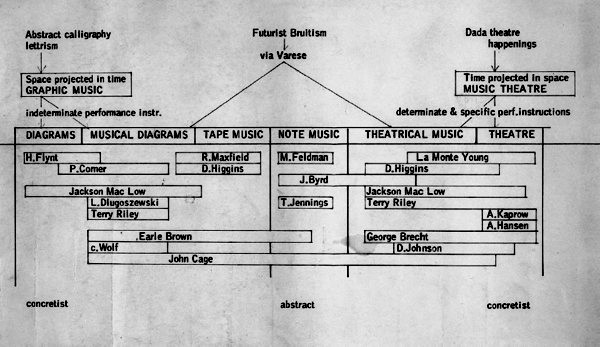 | George Maciunas, "Space projected in time GRAPHIC MUSIC / Time projected in space MUSIC THEATRE", ca. dec. 1961 |
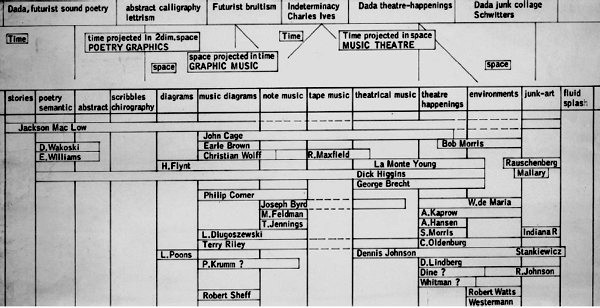 | George Maciunas, "Space projected in 2 dim. space POETRY GRAPHICS / Space projected in time GRAPHIC MUSIC / Time projected in space MUSIC THEATRE", ca. 1962 |
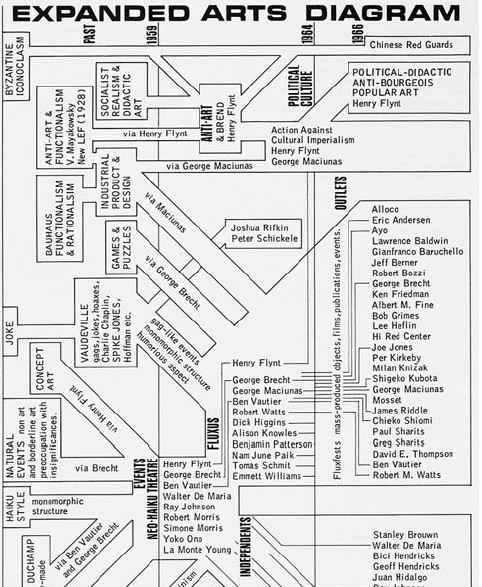 | George Maciunas, "Expanded Arts Diagram", back page of "Fluxfest Sale" (New York, 1966) |
| George Maciunas, "Fluxus (Its historical development and relationship to Avant-Garde movements)", 1966 | |||||||||||||||||||
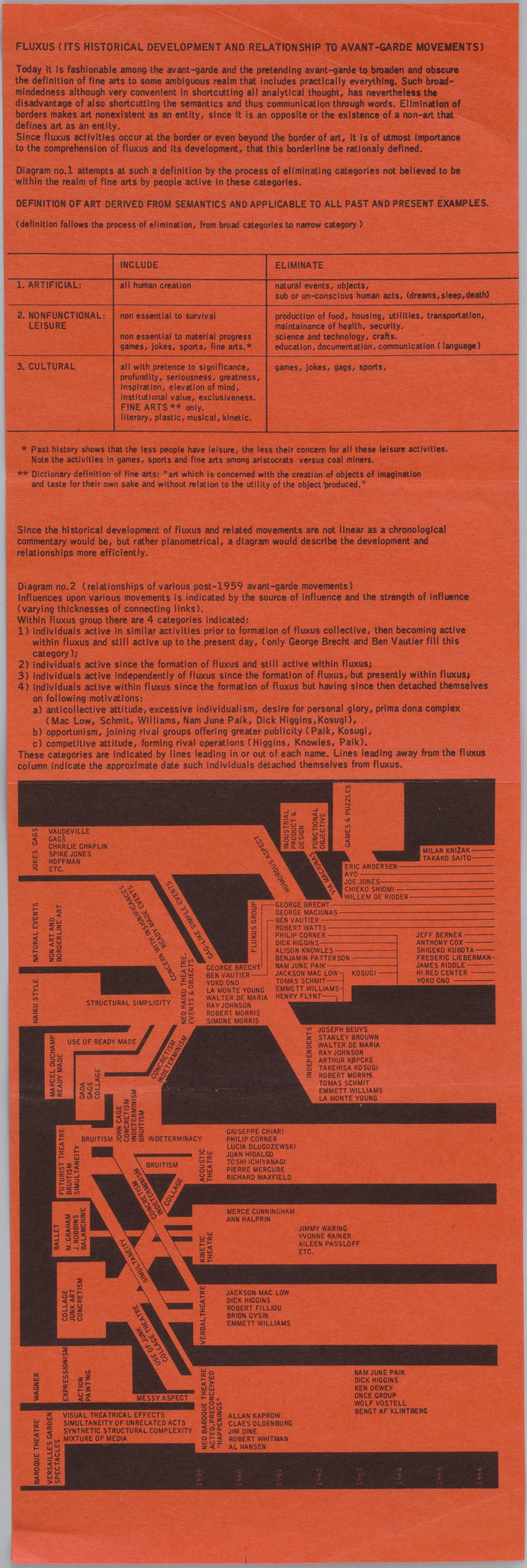 |
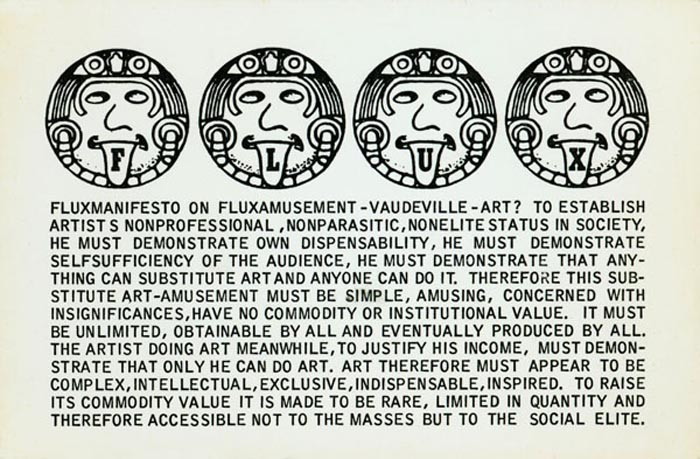 | George Maciunas, "Flux Manifesto on Flux Art Amusement", 1965 |
| ART To justify artist's professional, parasitic and elite status in society, he must demonstrate artist's indispensability and exclusiveness, he must demonstrate the dependability of audience upon him, he must demonstrate that no one but the artist can do art. Therefore, art must appear to be complex, pretentious, profound, serious, intellectual, inspired, skillful, significant, theatrical, It must appear to be caluable as commodity so as to provide the artist with an income. To raise its value (artist's income and patrons profit), art is made to appear rare, limited in quantity and therefore obtainable and accessible only to the social elite and institutions | FLUXUS ART-AMUSEMENT To establish artist's nonprofessional status in society, he must demonstrate artist's dispensability and inclusiveness, he must demonstrate the selfsufficiency of the audience, he must demonstrate that anything can be art and anyone can do it. Therefore, art-amusement must be simple, amusing, upretentious, concerned with insignificances, require no skill or countless rehersals, have no commodity or institutional value. The value of art-amusement must be lowered by making it unlimited, massproduced, obtainable by all and eventually produced by all. Fluxus art-amusement is the rear-guard without any pretention or urge to participate in the competition of "one-upmanship" with the avant-garde. It strives for the monostructural and nontheatrical qualities of simple natural event, a game or a gag. It is the fusion of Spikes Jones Vaudeville, gag, children's games and Duchamp. |
 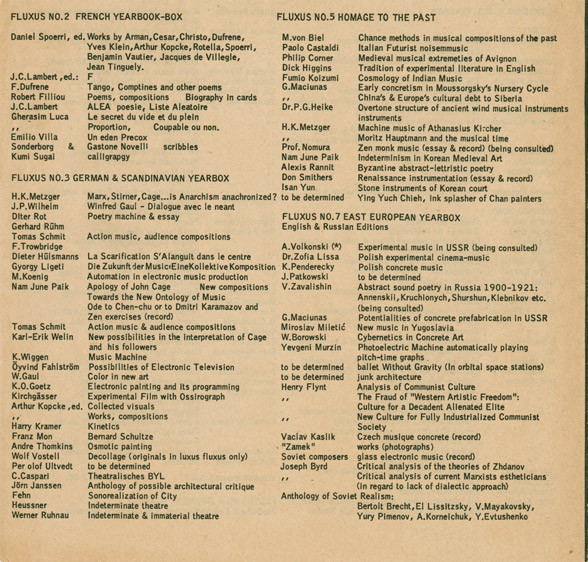  | George Maciunas, "Fluxus Year Boxes" (1962) |
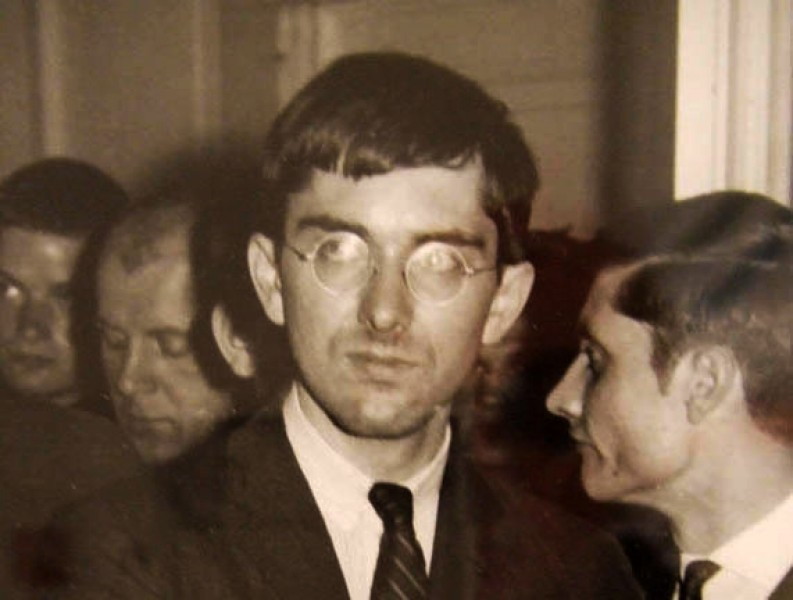 |
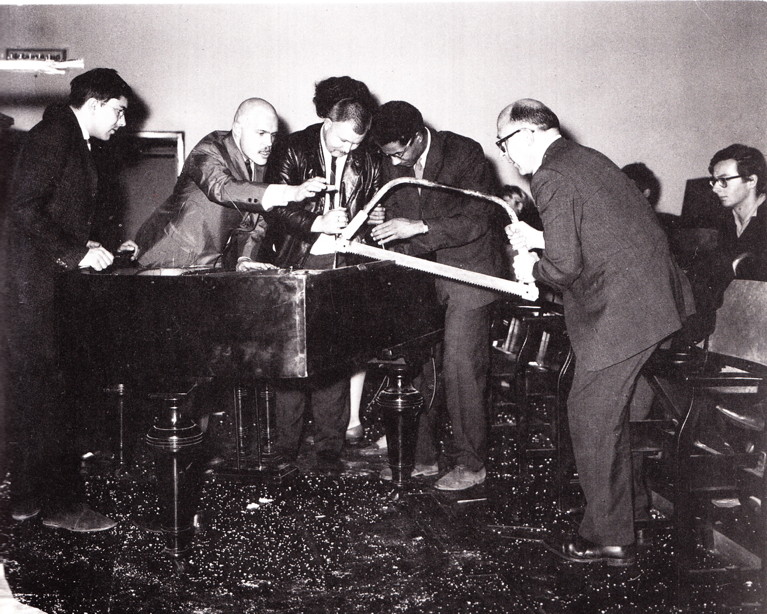 | George Maciunas, Dick Higgins, Wolf Vostell, Benjamin Patterson, Emmett Williams performing Phillip Corner’s "Piano Activities" at Fluxus Internationale Festspiele Neuester Musik, Wiesbaden (1962) |
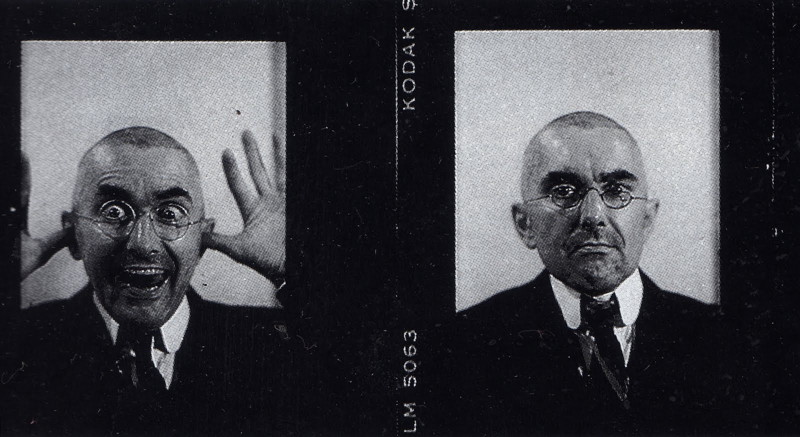 |
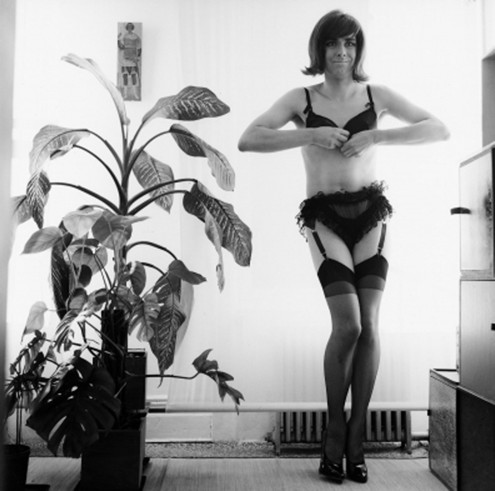 | George Maciunas performing for self-exposing camera, New York in 1966 |
VIDEOS(Edit)
Jean Dupuy's story about George Maciunas (2011)
Andy Warhol + George Maciunas (Jonas Mekas, 1971)
Marriage of George and Billy Maciunas (1978)
VIDEO WORKS (MACIUNAS)(Edit)
George Maciunas - Fluxus 1000 frames (1960)
George Maciunas - End After 9 (1966)
George Maciunas - 10 Feet (1966)
George Maciunas - Artype (1966)
